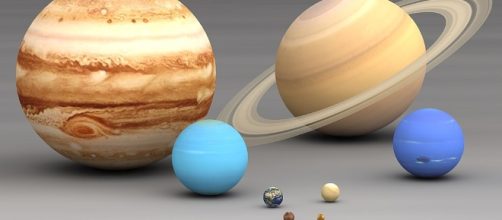Scientists have been speculating that the rain in Neptune and Uranus is not made of water. Today, a novel experiment successfully simulated the atmosphere of the outer planets and found proof that diamond showers may fall down from their skies.
The atmosphere of the Ice Giants
Years of research about Neptune and Uranus have led scientists to suspect that the planets experience diamond rain. However, proving the phenomenon was difficult due to the lack of actual evidence to corroborate the claim. In the past, researchers have tried to prove the speculation by simulating the conditions that led to a diamond rain.
However, mimicking the intense atmospheric pressure of the outer planets was a difficult feat to accomplish. Hence, the theory remained unconfirmed.
The physics of the Neptune and Uranus are significantly different from Earth. Dubbed as the Ice Giants, the planets situated at the outer end of the Solar System are extremely cold. The solid core of these planets is surrounded by freezing oceans made up of water, hydrocarbons, and ammonia. About 6,200 miles from their surface, the pressure rise to extreme levels. Scientists believe that these conditions lead to the formation of diamonds.
Novel method proves the possibility of a diamond rain
Today, Smithsonian reports the huge success of a group of international scientist that was researching on the possibility of a diamond rain.
Smithsonian reports about the huge success of a group of scientists that studied the possibilities of a diamond rain in Neptune and Uranus. Using a new method of simulating atmospheric conditions, the group successfully secured the very first evidence that corroborates the speculations.
The study which was published in the Nature Astronomy journal was led by Dominik Kraus, a fellow of the Helmholtz-Zentrum Dresden-Rossendorf research laboratory in Germany.
According to Kraus, the production of diamonds requires the right mix of methane, hydrogen, and helium. As hinted by their distinct blue color, the condition exists in the atmospheres of the ice giants.
In order to achieve the desired pressure, Kraus and his team produced shock waves using high-powered x-rays and optical laser.
The team also made use of polystyrene, a type of plastic that is made up of carbon and hydrogen. At about 150 gigapascals of pressure coupled with a temperature over 9,000 degrees Fahrenheit, the bonds between carbon and hydrogen molecules in the plastic broke and microscopic diamonds were formed from the compressed carbon atoms.
What’s more interesting is the theory that diamonds do not only rain in Neptune and Uranus. With the harsh conditions of the planets, diamond icebergs could be floating freely in its oceans. While information is scarce, the wonders of the Outer Planets remains a mystery.


